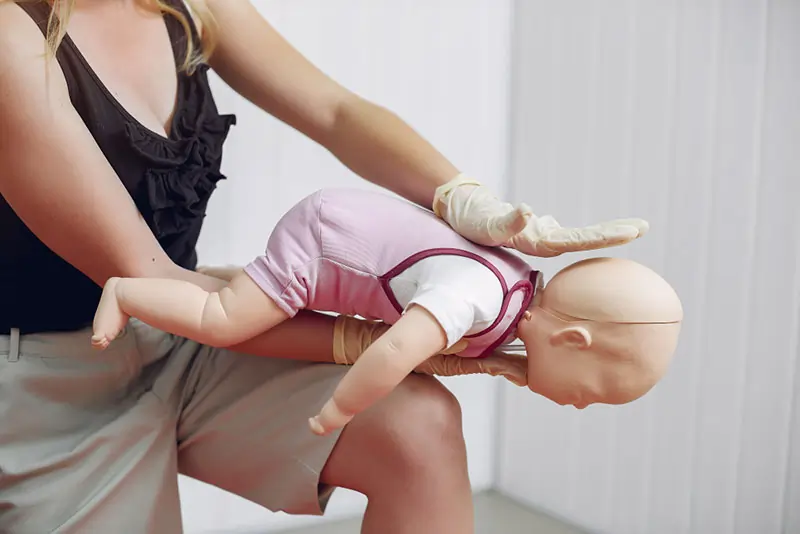Is Infant CPR Training Required for Childcare Providers?
When it comes to safeguarding children, childcare providers are the first responders in an emergency. Beyond just nurturing and educating, they face more responsibilities of handling life-threatening situations like respiratory issues, choking, drowning, or severe injuries.
These emergencies make it essential for childcare providers to be experienced in techniques like infant CPR for the children’s safety and protection.
The alarming statistics show that the mortality rate due to cardiac arrest in infants is about 90%. These situations highlight the importance of infant CPR training, which can significantly increase the survival rate of infants.
Why Should Childcare Providers Know Infant CPR?
Since babysitters and other childcare providers spend a lot of time with children, they must be trained in life-saving skills like CPR. CPR training can prepare them for various emergencies, helping them respond quickly and keep the child alive until professional help arrives. This training not only boosts their confidence but also helps them remain calm under pressure.
While knowing basic CPR is crucial, it’s even more important to understand how to perform CPR specifically for infants and children.
The CPR techniques differ for infants and children based on their size and age.
- Infant CPR is for children under 1 year old, regardless of their size, and it involves fingers and thumb for chest compressions to ensure gentle yet effective pressure.
- Once a child is over one year of age, one or two hand compressions are suggested. Understanding these differences ensures that childcare providers can deliver effective and appropriate care quickly.
What Are The Scenarios Where You Need to Perform CPR?
Understanding the right time when a child might need CPR is necessary, as it should be started immediately if a child is not responding, lying unconscious, breathing abnormally, or stopped breathing entirely. Have a look at some common situations when infant CPR training could be lifesaving:
● Drowning in Water:
When a child is at a pool, beach, or lake, it is important to keep an eye on them and never leave their side. However, if it happens and a child swallows too much water while swimming, this can lead to lung flooding, making them unconscious and struggling for air. Infant CPR can help throw out water from the lungs and restore normal breathing.
● Suffocation
Chances of accidental suffocation are very high during sibling play, especially when children are unsupervised. You would never know when the gameplay goes wrong, and they are suffocating under the pillow or due to being entangled with objects. CPR at the right time may help to get back their breathing.
● Choking
Children love to eat whatever comes their way. This could also happen when feeding large chunks of food, which can pose a risk of choking. As a precaution, always ensure that the food is chopped into small pieces. However, despite precautions, if it is a case of choking, CPR may help to remove the object from the airways and restore breathing.
● Injury
Children are naturally curious and energetic and want to experiment with everything that comes their way, often resulting in injuries from falling or hitting the wall. If a child becomes unconscious in these situations, CPR should be the instant step.
● Electrocution:
If a child happens to put their fingers or metal toys into electric outlets, this could lead to electrical shock. In such cases, moving children to safety and giving them CPR could be life-saving.
● Allergic Reactions:
Severe allergic reactions to bee stings or peanuts, such as anaphylaxis or allergic asthma, can cause swelling of the airways, preventing the child from breathing. A quick CPR can save their life.
● Cardiac Arrest:
Although more common in adults, according to the latest research, about 20,000 children experience cardiac arrest each year in the USA. Whether due to congenital issues or respiratory issues, timely intervention with CPR can stabilize the child in such situations.
Benefits of Infant CPR Training For Childcare Providers
Learning infant CPR provides a secure and nurturing environment for children’s growth and development, which enables childcare providers to focus on nurturing and learning experiences. Here are some additional advantages of getting trained in infant CPR:
- Being trained in infant CPR ensures that childcare providers are prepared for any situation, building a safe environment for the child in Lifesaving Moments.
- If the childcare providers are trained in CPR techniques, it sends a strong message to parents that their child is in safe hands. It also helps build trust and promote open communication between parents and caregivers.
- Some states require a certificate in infant CPR. This is a necessary step not only to prepare for medical emergencies but also to boost career growth and fulfill legal obligations.
Final Thoughts
Being trained in infant CPR prepares childcare providers to handle emergencies such as choking, injuries, drowning, or even sudden cardiac arrest. By learning lifesaving techniques, such as CPR and the use of an AED, childcare professionals create a safer environment for children placed under their care and protection.
While obtaining a BLS certification does require time and effort, the confidence and possible life-saving opportunities that accompany this training pay for themselves in ways other investments could hardly hope to. Therefore, childcare providers should make this a priority to ensure that the young lives within their care are as healthy and safe as possible.


